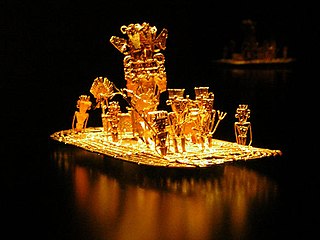
In folklore, a mermaid is an aquatic creature with the head and upper body of a female human and the tail of a fish. Mermaids appear in the folklore of many cultures worldwide, including Europe, Asia, and Africa.
The Tupi-Guarani mythology is the set of narratives about the gods and spirits of the different Tupi-Guarani peoples, ancient and current. Together with the cosmogonies, anthropogonies and rituals, they form part of the religion of these peoples.

The bogeyman is a mythical creature typically used to frighten children into good behavior. Bogeymen have no specific appearances, and conceptions vary drastically by household and culture, but they are most commonly depicted as masculine or androgynous monsters that punish children for misbehavior. The bogeyman, and conceptually similar monsters can be found in many cultures around the world. Bogeymen may target a specific act or general misbehaviour, depending on the purpose of invoking the figure, often on the basis of a warning from an authority figure to a child. The term is sometimes used as a non-specific personification of, or metonym for, terror – and sometimes the Devil.
Pichal peri or pichhal pairī is the name given to the churel in northwestern South Asia and Central Asia because of their typical appearance as a woman with long hair covering the face and feet pointing backward.
Pedro Penduko is a Filipino fictional comic book character created by National Artist for Literature Francisco V. Coching. The character, who is styled as a folk hero, debuted in the magazine Liwayway in 1954.

The Patasola or "single leg" is one of many legends in Colombian folklore about female monsters from the jungle, appearing to male hunters or loggers in the middle of the wilderness when they think about women. The Patasola appears in the form of a beautiful seductive woman, often in the likeness of a loved one, who lures a man away from his companions deep into the jungle. There, the Patasola reveals her true, hideous appearance as a one-legged creature with ferocious vampire-like lust for human flesh and blood, attacking and devouring the flesh or sucking the blood of her victims.
The Chilote mythology or Chilota mythology is formed by the myths, legends and beliefs of the people who live in the Chiloé Archipelago, in the south of Chile. This mythology reflects the importance of the sea in the life of Chilotes.

Iara, also spelled Uiara, Yara or Hiara or Mãe das Águas, is a figure from Brazilian mythology based on Tupi and Guaraní mythology. The word derives from Nheengatu iiyara = ií ("water") + yara. Depending on the oral tradition and the context of the story, she can be seen either as a water nymph, a siren, or a beautiful mermaid that lives in the Amazon River.

Colombian folklore are beliefs, customs and cultural traditions in Colombia.

Mythic humanoids are legendary, folkloric, or mythological creatures that are part human, or that resemble humans through appearance or character. Each culture has different mythical creatures that come from many different origins, and many of these creatures are humanoids. They are often able to talk and in many stories they guide the hero on their journey.

Literature of the Dominican Republic refers to works written in the country or outside of it by writers, either by nationality or ancestry. Although one can only speak rigorously of Dominican literature in relation to works written after Dominican Independence, it is customary to include the literary production of the colonial era. During the colonial period, Cristóbal de Llerena wrote the interlude Octava de Corpus Christi and Leonor de Ovando wrote some sonnets, which is why she is considered the first woman to write poetry on this side of the world. Modern Dominican literature began with the founding of the first cultural society Lovers of Letters, to which Manuel de Jesús Galván, Jose Gabriel García, Francisco Javier Angulo Guridi, Manuel de Jesus Heredia, Manuel Rodríguez Objío, among others, belonged.

A bhoota is a supernatural creature, usually the ghost of a deceased person, in the popular culture, literature and some ancient texts of the Indian subcontinent. Interpretations of how bhootas come into existence vary by region and community, but they are usually considered to be perturbed and restless due to some factor that prevents them from moving on. This could be a violent death, unsettled matters in their lives, or simply the failure of their survivors to perform proper funerals.

The Carnival in the Dominican Republic is celebrated in most cities and towns in the main streets of the country. Among its most notable characteristics are its flashy elaborate costumes and traditional masks. The carnival held in the city of La Vega, which is one of the biggest in the country, and the national parade in Santo Domingo, were the first Carnivals held in the Americas in the early 1500s.

Knowledge of Muisca mythology has come from Muisca scholars Javier Ocampo López, Pedro Simón, Lucas Fernández de Piedrahita, Juan de Castellanos and conquistador Gonzalo Jiménez de Quesada who was the European making first contact with the Muisca in the 1530s.

Alejandro Angulo Guridi was a Dominican writer and politician, who held the portfolios of Justice and Foreign Affairs. According to some historians, he wrote the first Dominican short story and probably also the first novel. His contributions to Dominican literature toom him throughout Latin America, making him perhaps one of the most infuencial Dominican writers of the 19th-century.

The Galipote, also called Zángano or Lugarú, is a legendary character from the Dominican Republic, originally from San Juan, which probably dates back to the 17th and 18th centuries. It was a mythical being characterized by the ability to transform into different animals and inanimate objects, as well as enjoying atrocious strength and immunity against firearms. It was said that he used to feed on the blood of innocent children, with which he obtained eternal life; it is also said that they practiced macabre sexual acts with them.











